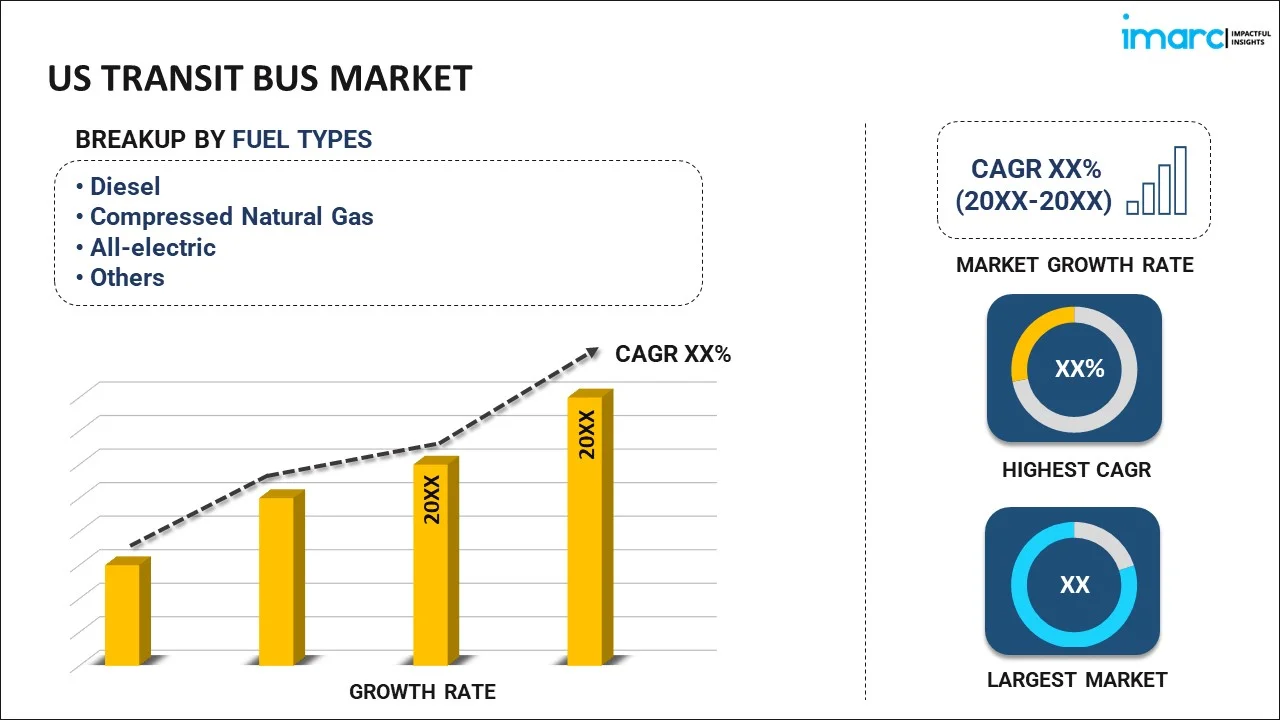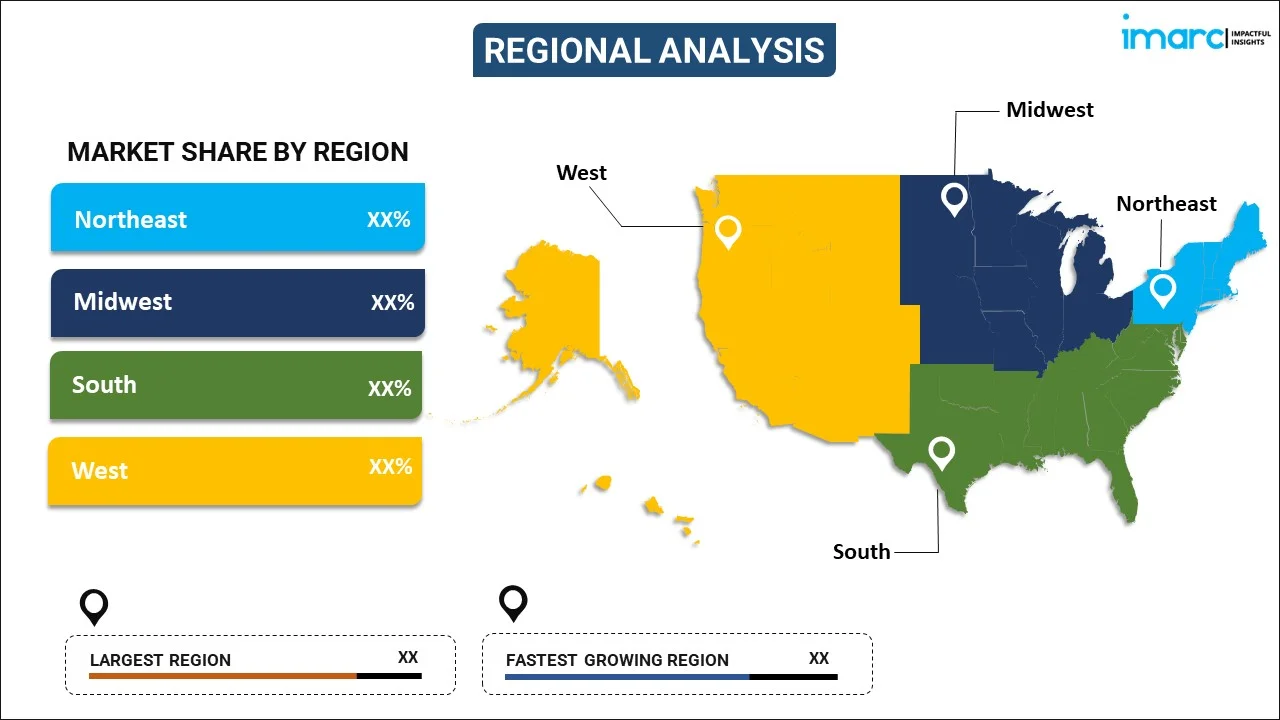
US Transit Bus Market Report by Fuel Type (Diesel, Compressed Natural Gas, All-electric, Fuel Cell Electric Vehicle, Hybrid), Application (Urban Transit, Suburban Transit, Intercity, and Others), Seating Capacity (Below 40 Seats, 40-70 Seats, Above 70 Seats), and Region 2024-2032
Market Overview:
US transit bus market market size reached US$ 2.65 Billion in 2023. Looking forward, IMARC Group expects the market to reach US$ 5.08 Billion by 2032, exhibiting a growth rate (CAGR) of 7.10% during 2024-2032. The increasing advances in bus technology, such as the development of electric and autonomous buses, which can enhance the efficiency, safety, and overall appeal of transit system, are driving the market.
|
Report Attribute
|
Key Statistics
|
|---|---|
|
Base Year
|
2023 |
|
Forecast Years
|
2024-2032 |
|
Historical Years
|
2018-2023
|
| Market Size in 2023 | US$ 2.65 Billion |
| Market Forecast in 2032 | US$ 5.08 Billion |
| Market Growth Rate (2024-2032) | 7.10% |
A transit bus is a public vehicle designed to carry a large number of passengers on scheduled routes within urban, suburban, and intercity areas. These buses serve as a vital component of
mass transit systems, providing an efficient and cost-effective means of transportation for commuters. Typically featuring spacious interiors, seating arrangements, and standing areas, transit buses aim to accommodate diverse passenger needs. They are often equipped with accessibility features, such as ramps or lifts, to ensure inclusivity for individuals with mobility challenges. Transit buses contribute to reducing traffic congestion, lowering carbon emissions, and promoting sustainable urban mobility. Municipalities and transportation authorities manage and operate these buses, emphasizing reliability, frequency, and coverage to enhance public accessibility and encourage the use of public transportation.
US Transit Bus Market Trends:
The transit bus market in the US is experiencing substantial growth, driven by several key factors. Firstly, the increasing urbanization has led to a rising demand for efficient public transportation systems, making transit buses a crucial component of modern urban mobility. Additionally, the escalating awareness of environmental concerns has prompted a shift towards sustainable transportation solutions, with transit buses being recognized as a cleaner alternative to individual car usage. Moreover, advancements in technology have played a pivotal role in enhancing the appeal of transit buses, with features such as GPS tracking, real-time information systems, and eco-friendly propulsion systems contributing to their attractiveness. Furthermore, governments in the US are actively investing in public transportation infrastructure, thereby fueling the expansion of the transit bus market. Subsidies, incentives, and regulatory policies geared towards promoting the adoption of eco-friendly vehicles are providing a significant impetus to the industry. The growing focus on reducing traffic congestion and improving air quality in urban areas further propels the demand for transit buses. In conclusion, a confluence of urbanization, environmental consciousness, technological innovations, government support, and a commitment to sustainable transportation collectively drive the thriving transit bus market.
US Transit Bus Market Segmentation:
IMARC Group provides an analysis of the key trends in each segment of the market, along with forecasts at the country level for 2024-2032. Our report has categorized the market based on fuel type, application, and seating capacity.
Fuel Type Insights:

- Diesel
- Compressed Natural Gas
- All-electric
- Fuel Cell Electric Vehicle
- Hybrid
The report has provided a detailed breakup and analysis of the market based on the fuel type. This includes diesel, compressed natural gas, all-electric, fuel cell electric vehicle, and hybrid.
Application Insights:
- Urban Transit
- Suburban Transit
- Intercity
- Others
A detailed breakup and analysis of the market based on the application have also been provided in the report. This includes urban transit, suburban transit, intercity, and others.
Seating Capacity Insights:
- Below 40 Seats
- 40-70 Seats
- Above 70 Seats
The report has provided a detailed breakup and analysis of the market based on the seating capacity. This includes below 40 seats, 40-70 seats, and above 70 seats.
Regional Insights:

- Northeast
- Midwest
- South
- West
The report has also provided a comprehensive analysis of all the major regional markets, which include Northeast, Midwest, South, and West.
Competitive Landscape:
The market research report has also provided a comprehensive analysis of the competitive landscape. Competitive analysis such as market structure, key player positioning, top winning strategies, competitive dashboard, and company evaluation quadrant has been covered in the report. Also, detailed profiles of all major companies have been provided.
US Transit Bus Market Report Coverage:
| Report Features | Details |
|---|---|
| Base Year of the Analysis | 2023 |
| Historical Period | 2018-2023 |
| Forecast Period | 2024-2032 |
| Units | US$ Billion |
| Scope of the Report | Exploration of Historical Trends and Market Outlook, Industry Catalysts and Challenges, Segment-Wise Historical and Future Market Assessment:
|
| Fuel Types Covered | Diesel, Compressed Natural Gas, All-electric, Fuel Cell Electric Vehicle, Hybrid |
| Applications Covered | Urban Transit, Suburban Transit, Intercity, Others |
| Seating Capacities Covered | Below 40 Seats, 40-70 Seats, Above 70 Seats |
| Regions Covered | Northeast, Midwest, South, West |
| Customization Scope | 10% Free Customization |
| Report Price and Purchase Option | Single User License: US$ 3699 Five User License: US$ 4699 Corporate License: US$ 5699 |
| Post-Sale Analyst Support | 10-12 Weeks |
| Delivery Format | PDF and Excel through Email (We can also provide the editable version of the report in PPT/Word format on special request) |
Key Questions Answered in This Report:
- How has the US transit bus market performed so far and how will it perform in the coming years?
- What has been the impact of COVID-19 on the US transit bus market?
- What is the breakup of the US transit bus market on the basis of fuel type?
- What is the breakup of the US transit bus market on the basis of application?
- What is the breakup of the US transit bus market on the basis of seating capacity?
- What are the various stages in the value chain of the US transit bus market?
- What are the key driving factors and challenges in the US transit bus?
- What is the structure of the US transit bus market and who are the key players?
- What is the degree of competition in the US transit bus market?
Key Benefits for Stakeholders:
- IMARC’s industry report offers a comprehensive quantitative analysis of various market segments, historical and current market trends, market forecasts, and dynamics of the US transit bus market from 2018-2032.
- The research report provides the latest information on the market drivers, challenges, and opportunities in the US transit bus market.
- Porter's five forces analysis assist stakeholders in assessing the impact of new entrants, competitive rivalry, supplier power, buyer power, and the threat of substitution. It helps stakeholders to analyze the level of competition within the US transit bus industry and its attractiveness.
- Competitive landscape allows stakeholders to understand their competitive environment and provides an insight into the current positions of key players in the market.
Need more help?
- Speak to our experienced analysts for insights on the current market scenarios.
- Include additional segments and countries to customize the report as per your requirement.
- Gain an unparalleled competitive advantage in your domain by understanding how to utilize the report and positively impacting your operations and revenue.
- For further assistance, please connect with our analysts.
 Inquire Before Buying
Inquire Before Buying
 Speak to an Analyst
Speak to an Analyst
 Request Brochure
Request Brochure
 Request Customization
Request Customization




.webp)




.webp)












